Life Cycle Assessment¶
Authors and date
- Submitted on: July 12th 2021
- Sophie Quinton: Researcher at Inria Grenoble (SPADES team)
- Jacques Combaz, Research engineer (CNRS / VERIMAG)
This sheet, automatically translated by the Deepl tool, has not been proofread by its author
What is a life cycle assessment (LCA)?¶
Whether at the level of citizens, companies or States, acting to reduce our environmental impacts requires an understanding of the cause and effect links between our actions and these impacts. In the case of goods and services, it seems essential to have reliable and recognized methods to analyze the environmental impacts that can be associated with them throughout their life cycle.
Life cycle assessment is a method of quantified evaluation of the environmental impacts of a product (which can be a good or a service). This method is formalized by the international standards ISO 14040:2006 and ISO 14044:2006. It should be noted that an LCA quantifies the environmental impacts in normal operation, i.e. without taking into account potential accidents.
Compared to other methods (such as the ecological footprint, the carbon footprint...), LCA is distinguished by its multi-criteria and multi-step character.
- Multi-criteria: different categories of environmental impacts are studied (global warming potential, depletion of abiotic resources, creation of photochemical ozone, water, air and soil pollution, human toxicity, loss of biodiversity, etc.). These impacts are related to different spatial (from local to global) and temporal (from short term to long term) scales.
- Multi-stage: the different phases of the life cycle are taken into account (extraction of raw materials, manufacturing, transport, use, end of life).
These two dimensions allow for a broad understanding of the environmental impacts associated with a product, in order to avoid that impact reduction initiatives only result in fine in transfers to other life cycle stages or other types of impacts.
Two examples of LCA results are illustrated below (we will come back to them later).
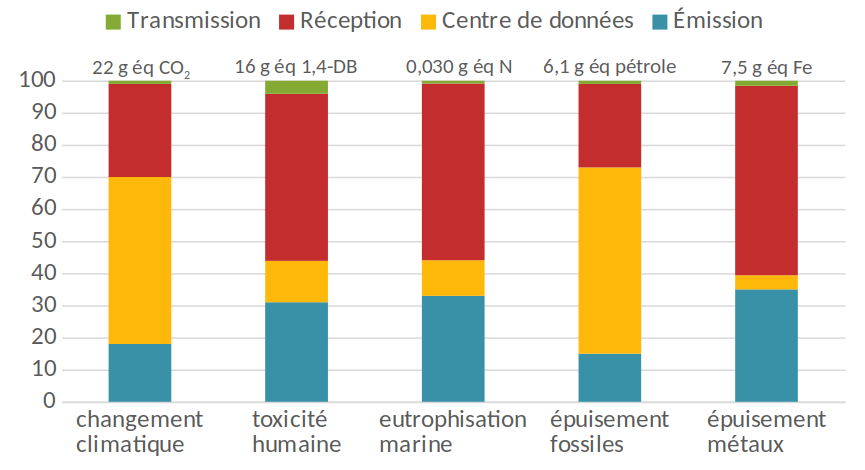 Figure 1: Synthesis of the LCA results of sending a 1 MB email according to a study by ADEME 1.
Figure 1: Synthesis of the LCA results of sending a 1 MB email according to a study by ADEME 1.
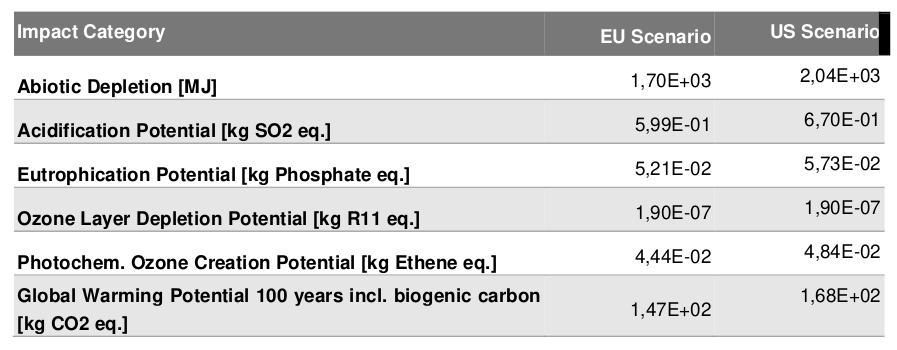 Figure 2: Summary of the results of the LCA of the Dell Latitude 7300 2. The environmental impact categories considered are: abiotic resource depletion, acidification potential, eutrophication potential, ozone depletion potential, photochemical ozone creation potential, global warming potential. The LCA considers two usage scenarios, one in Europe and one in the United States.
Figure 2: Summary of the results of the LCA of the Dell Latitude 7300 2. The environmental impact categories considered are: abiotic resource depletion, acidification potential, eutrophication potential, ozone depletion potential, photochemical ozone creation potential, global warming potential. The LCA considers two usage scenarios, one in Europe and one in the United States.
The main principles of LCA¶
Conducting an LCA consists first of all of conducting a detailed study of the material and energy flows (between different human activities and with the environment) corresponding to the different stages of the life cycle of a product. These flows are then translated into indicators quantifying different categories of impacts.
Most published LCA results are based on attributional LCA (A-LCA), which aims to attribute to a product its "fair share" of all environmental impacts (in a steady-state system). If we are interested in the consequences of the introduction of a new product (or of an increase in the quantities produced, or of changes in its life cycle, etc.), we must in principle resort to a consequential LCA (LCA-C). In the following, we detail the main steps of LCA-A.
The main steps of LCA-A¶
A life cycle assessment is an iterative process that takes place in 4 main steps.
- Definition of the objectives and scope of the study
- Life cycle inventory
- Environmental impact assessment
- Interpretation of the results
In concrete terms, the result of a life cycle assessment is presented in the form of a report documenting all of these steps in a rigorous and transparent manner. In some cases, this report is critically reviewed by an independent expert. The studies mentioned in figures 1 and 2 are two examples 3.

Figure 3: The main steps of LCA.
Definition of the objectives and scope of the study¶
This step specifies the objective of the study (e.g. to compare two products) and the use that will be made of the results (e.g. to communicate or to help in decision-making). It also allows the specification of the functional unit, which is a quantified characterization of the main function(s) of the product studied, in order to allow comparisons "with equal function(s)". For example, in the LCA of sending an email (Figure 1), the functional unit can be stated as follows: "Transmit a 1 MB document to a person". The boundaries of the system (what will be taken into account and what will be disregarded) and additional assumptions on the scenario(s) studied (such as the life span of the equipment, the nature of the material used, the geographical area concerned, etc.) are specified in addition to the functional unit. The reference flow is also added, which corresponds to the quantity of product necessary to fulfill the function described by the functional unit.
Life cycle inventory¶
The life cycle inventory is the heart of the LCA. It consists of breaking down the stages of production, transformation or consumption that take place in the life cycle of the specified functional unit. This decomposition continues until elementary processes appear as building blocks, which are simple enough to be modeled directly, or for which adequate information can be found in the available databases. A scaling step of the elementary processes is usually necessary to ensure that the quantities correspond to the functional unit.
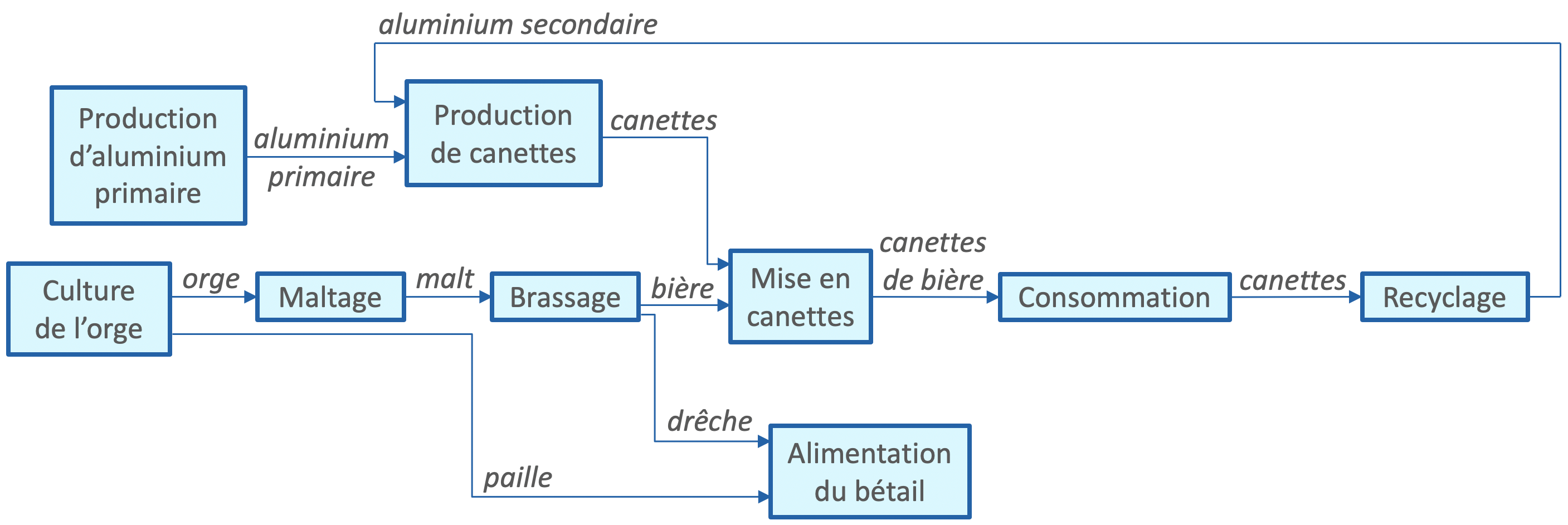
Figure 4: Decomposition of the life cycle of a beer can into elementary processes. The quantitative aspects of the flows are not represented here, nor are the exchanges with the environment.
An elementary process is characterized both by the flows it exchanges within the economic system (inputs and outputs) and by those it exchanges with the environment (natural resources and final pollution/waste, omitted in Figure 4).
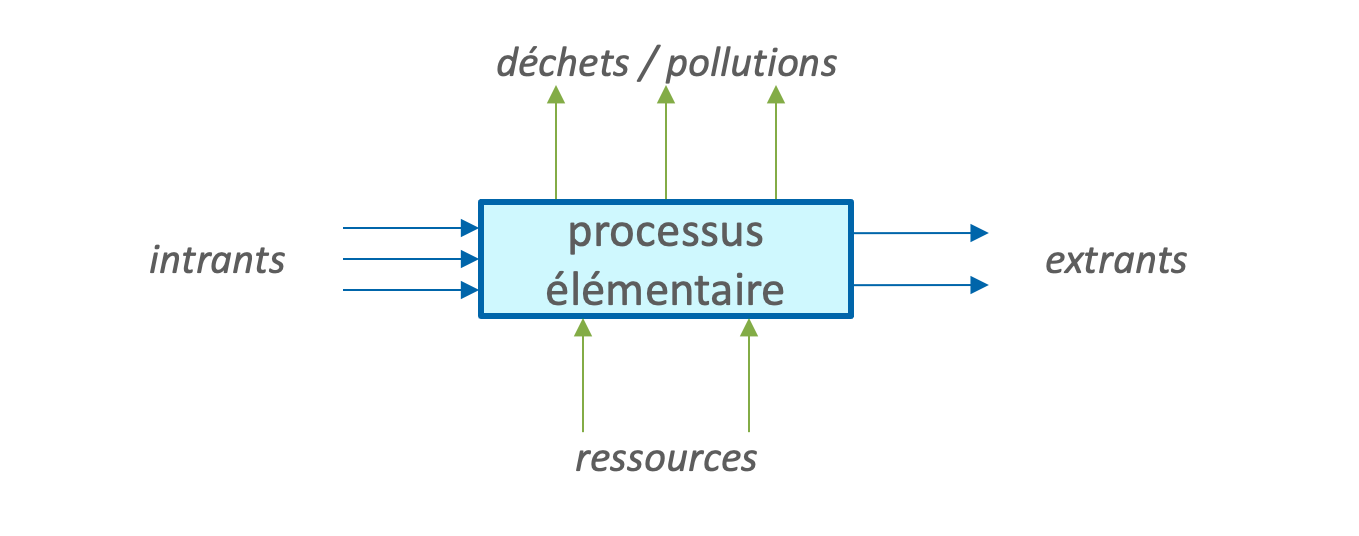 Figure 5: Graphical representation of an elementary process. An elementary process is fed by physical flows (inputs and natural resources) and produces others (outputs and final waste/pollution).
Figure 5: Graphical representation of an elementary process. An elementary process is fed by physical flows (inputs and natural resources) and produces others (outputs and final waste/pollution).
The delicate points of these first two steps of the LCA concern, among others:
- the boundaries of the system, which define the processes to be included to satisfy the functional unit (it is possible to exclude some processes, for example because they are negligible);
- the quality of the modelling and in particular the origin of the data (difficulty to collect the primary technical data, problem of availability of representative, current and reliable data in the databases);
- the multi-functionality, which means that the same elementary process can participate both in the functional unit and in other life cycles (this is the case of barley cultivation and brewing in the example of figure 4: they are involved both in beer production and in livestock feeding);
- the choice of a relevant subset of impact categories for which indicators are to be produced.
Environmental impact assessment¶
The evaluation of environmental impacts consists of producing environmental indicators from the flows exchanged with the environment obtained in the previous step, which differ according to the evaluation method used. This step requires the aggregation of flows of different natures, for example to express the global warming potential of different gases inCO2 equivalent (see figure 6). This principle is the same for all impact categories, which explains, for example, why metal depletion is expressed in iron equivalent (Fe eq) in Figure 1 (although the standard is rather antimony equivalent, Sb eq).

Figure 6: Characterization factors for global warming. These factors allow, for example, to convert methane (CH4) emissions intoCO2 equivalent (for a given time horizon because not all gases have the same persistence in the atmosphere), and more generally to aggregate the emissions of different greenhouse gases into a single indicator.
Interpretation and formatting of results¶
This step is essential to highlight the salient points of the analysis, to point out its limitations (uncertainties, sensitivity to assumptions, etc.), and to specify the conclusions that can be drawn from it.
Understand the results of an LCA¶
It is not always easy to fully understand the reality described by the results of an LCA. Here are some additional elements that may be useful.
Scope of the study: the functional unit, the use scenario and the reference flow play an essential role in the results obtained. For example, in the case of sending an email of 1 MB described in figure 1, it is essential to specify what this action covers: for example, is writing the email taken into account, and if so, what is the estimated duration? Similarly, the geographical area of computer use analyzed in Figure 2 must be specified and has a significant influence on the values obtained (due, among other things, to the differences in the electricity mix of the countries considered).
Underlying physical reality: having quantified the impacts associated with, for example, a calculation carried out on a server, one might be tempted to conclude that one less calculation would reduce the observed impacts accordingly, which is not necessarily the case. Indeed, in an LCA-A, the impacts due to the static (fixed) electrical power of the server are distributed among all the calculations performed on this server (see figure 7). However, deleting a calculation has no effect on this fraction of the impacts since it does not reduce the static consumption (unless the server is switched off)! Remember that the consequences of a variation in demand are the subject of LCA-C and not of LCA-A.
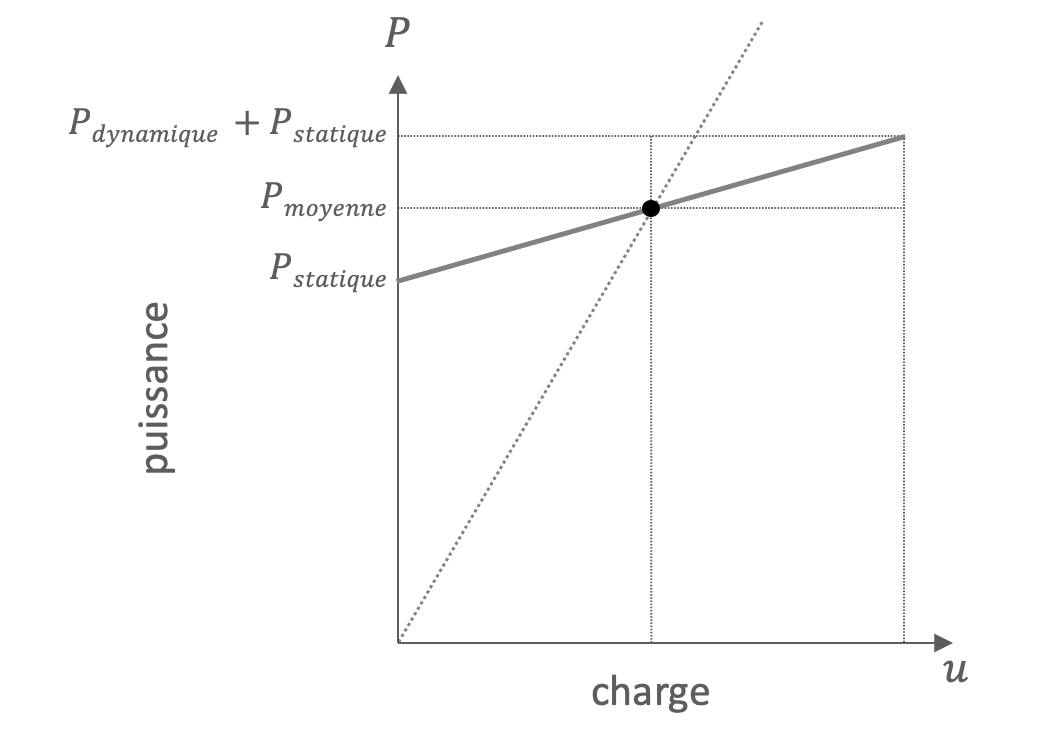 Figure 7: Typical electrical power of a compute server as a function of its processor load (gray line). The power varies relatively little as the load increases because a large part of the power is static. In other words, there is a case of energy non-proportionality (see Concept sheet "Digital and electricity: measurements, proportionality and energy efficiency"Concept sheet "Digital and electricity: measurements, proportionality and energy efficiency" ). In an LCA-A, impacts are attributed according to the processor load, and the impacts related to static power are distributed over the calculations (based on the average power of the server), as if the power were linear (dotted line).
Figure 7: Typical electrical power of a compute server as a function of its processor load (gray line). The power varies relatively little as the load increases because a large part of the power is static. In other words, there is a case of energy non-proportionality (see Concept sheet "Digital and electricity: measurements, proportionality and energy efficiency"Concept sheet "Digital and electricity: measurements, proportionality and energy efficiency" ). In an LCA-A, impacts are attributed according to the processor load, and the impacts related to static power are distributed over the calculations (based on the average power of the server), as if the power were linear (dotted line).
Multi-functional accounting: There are many ways to allocate impacts related to a multi-functional process. It is important to understand these attribution mechanisms and the calculations that accompany them if we are to effectively reduce certain impacts. For example, most of the metals used in digital technology are mined only as by-products of other metals, i.e. the economic profitability of the mines from which they are extracted is ensured by the production of other metals. Reducing the consumption of metals in the digital sector would therefore not automatically reduce the impacts linked to the mines from which they are extracted. This is taken into account in the attribution conventions, but in general there is no single way to attribute impacts 4.
Conclusion¶
The life cycle assessment of a product (good or service) allows us to highlight and quantify its materiality and its environmental externalities. It does not aim to provide a clear-cut answer or a very precise figure, but rather to propose orders of magnitude and a profile of solutions. In this sense, and provided that the underlying methodological principles are well understood, LCA is a particularly useful tool for communicating on the environmental impacts associated with a product, for comparing two products, for identifying certain possible levers for improvement, and more generally for assisting in the various decision-making processes 5 that aim to reduce our environmental impacts at all scales.
To go further¶
Dossier sur l'Analyse de Cycle de Vie par l'ADEME
Sources¶
-
Analyse comparée des impacts environnementaux de la communication par voie électronique, ADEME 2011 (page 7) ↩
-
The ADEME report cited above is in fact a summary of the 139-page LCA report. ↩
-
A concrete example of the issues involved in allocation is given by the milkman: agreements differ between cement and steel companies (see the article "Les Échos") so that some of their greenhouse gas emissions are not attributed. ↩
-
Beware, when these decisions concern large-scale changes it is the LCA-C methodology and not LCA-A that should be used. ↩